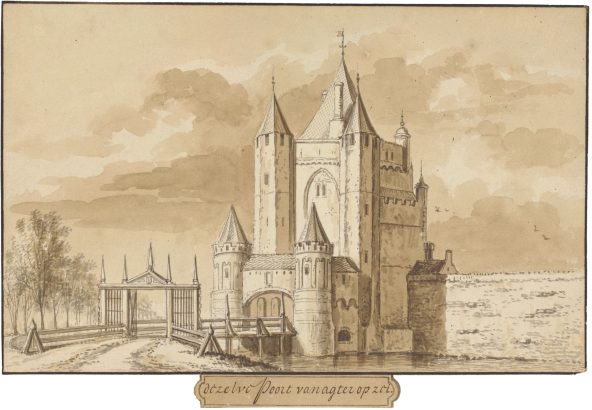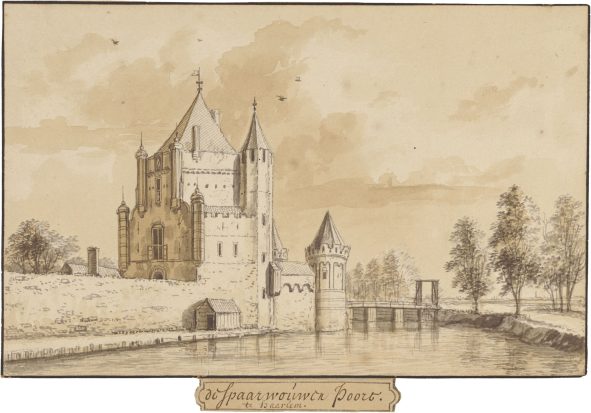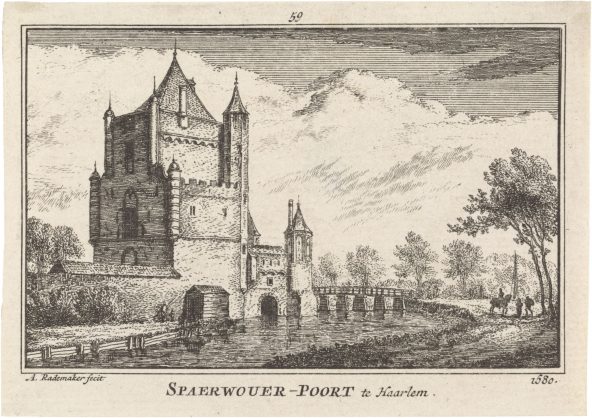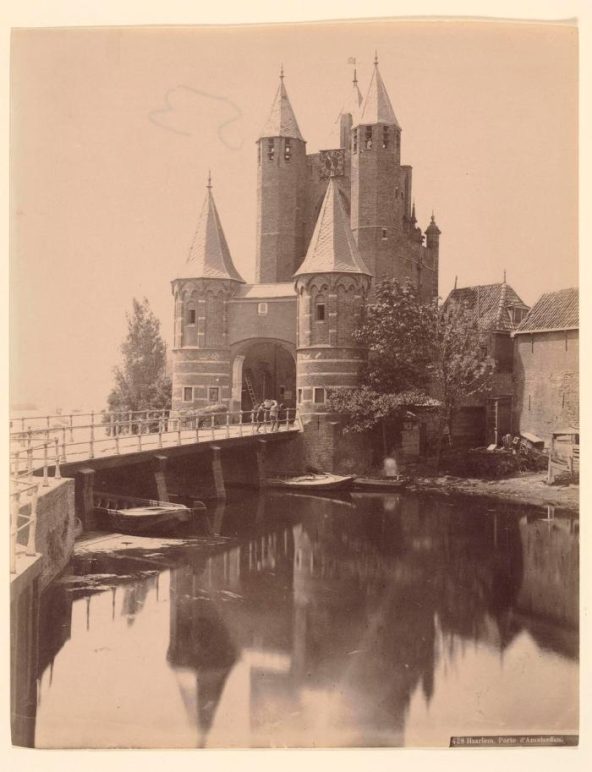Article: Abraham Rademaker and Haarlem’s Spaarnwouder Gate
Focus on the Peck Feature
In 1725, Abraham Rademaker (Dutch, 1675-1735) published his book Kabinet van Nederlandsche en Kleefsche Oudheden, which included 300 etchings depicting towns and historic architecture found in the northern Netherlands, the Rhine, and Cleeves. This Focus on the Peck Collection installation features two of the artist’s drawings of Haarlem’s Spaarnwouder Gate, the last gate to remain standing from the city’s medieval past, as well as his related etching, and a nineteenth-century photograph of the same structure. Since 1355, the gate served as one of twelve entry points into the city, and in 1631, it functioned as the primary entrance for passengers traveling via the Haarlemmertrekvaart canal between Haarlem and Amsterdam, a mere twelve miles away. Rademaker’s depictions of Spaarnwouder Gate serve as an invaluable record of Haarlem’s great past as well as that of the broader Dutch Republic.

Abraham Rademaker, Dutch, 1675 – 1735, A View of the Spaarnwouder Gate in Haarlem, c. 1730, graphite, pen and brown ink, and brown wash, The Peck Collection, 2017.1.117.
See A View of the Spaarnwouder Gate in Haarlem in more detail here.
Eighteenth-century Dutch artist Abraham Rademaker specialized in depictions of towns and historic locations found in and around the Dutch Republic of the northern Netherlands. In 1725, he published a book featuring 300 etchings highlighting important and well-known sites, including buildings and monuments in the city of Haarlem, located just twelve miles west of Amsterdam. In the late sixteenth and early seventeenth centuries, Haarlem enjoyed widespread economic success as a hub for the beer-brewing trade, shipbuilding, and textile manufacturing, and it attracted many talented artists, including several represented in the Peck Collection.
This Focus on the Peck Collection installation features two of Rademaker’s drawings of Haarlem’s Spaarnwouder Gate, a related etching by the artist, and a nineteenth-century photograph of the same structure. Built in 1355, the gate was one of twelve constructed as part of the city’s medieval defenses. It traditionally facilitated traffic by land, but in 1631 the Haarlemmertrekvaart canal was created alongside it, making the gate the city’s primary entry point for passengers traveling along the waterway between Haarlem and Amsterdam. Also known as the Amsterdam Gate, it serviced over 160,000 travelers arriving from Amsterdam in 1661. As the depictions of the only gate of its kind remaining in Haarlem today, Rademaker’s images serve as an invaluable record of Haarlem’s great past as well as that of the broader Dutch Republic.

Abraham Rademaker, Dutch, 1675 – 1735, Rear View of the Spaarnwouder Gate in Haarlem, c. 1730, graphite, pen and brown ink, and brown wash, The Peck Collection, 2017.1.118.
See Rear View of the Spaarnwouder Gate in Haarlem (drawing) in more detail here.
In each view of Haarlem’s Spaarnwouder Gate, seen from the front and the rear, Rademaker articulated the shape of the gate with great accuracy, using precise lines and delicate shading to create form, texture, and depth. The sunstruck medieval structure, calm water, soft clouds, and absence of people evoke a quiet, idyllic atmosphere.
In addition to producing his own drawings of the Dutch countryside as preparatory studies for etchings, Rademaker also modeled his compositions after drawings created by earlier artists, which is likely the case here.

Abraham Rademaker, Dutch, 1675 – 1735 (printmaker), Unidentified artist, late 17th century (designer), Rear View of the Spaarnwouder Gate in Haarlem, c. 1730, etching, The Peck Collection, 2017.1.132.
See Rear View of the Spaarnwouder Gate in Haarlem (etching) in more detail here.
This print belongs to a group of 300 etchings that Rademaker created for his book Kabinet van Nederlandsche en Kleefsche Oudheden, first published in 1725. The popular tome featured views of towns and historic architecture in the northern Netherlands, the Rhine, and Cleeves. To provide a more complete record of the sites, many of which had already fallen into ruin, Rademaker modeled some of his compositions on earlier drawings held in private collections. Where applicable, he indicated a date for his source drawing in each etching, in this instance 1680. Rademaker’s depiction of the Spaarnwouder Gate, based on a presumably lost composition, differs slightly from the etching. Notice the additional trees and shrubbery, the added people, the figure on horseback, and the towpath that now curves toward the bottom center of the composition.

Unidentified artist, Amsterdam Gate, Haarlem, 19th century, photograph, UNC Art Department Collection, 73.16.34.
See Amsterdam Gate, Haarlem in more detail here.
This photograph entered the collection in 1973 from the UNC Art Department Collection along with nearly 500 other nineteenth-century photographs of European historical sites, monuments, and art works. It shows the Spaarnwouder Gate (also called Amsterdam Gate) from the front as well as the Haarlemmertrekvaart canal, which at one time carried passengers between Haarlem and Amsterdam. In 1839 a railway built alongside the canal rendered water travel obsolete and by 1865, the city petitioned to demolish the gate due to disrepair. The government’s lack of funding, however, saved the building and in the 1960s it was declared a national monument. The gate, which was fully renovated in 1985, stands today as a reminder to both locals and tourists of Haarlem’s thriving medieval past and the city’s close relationship with nearby Amsterdam.
